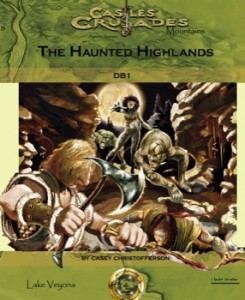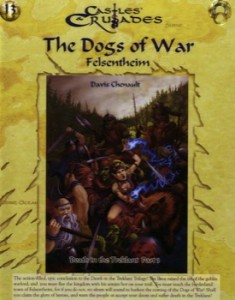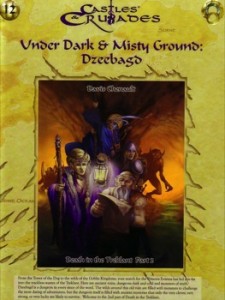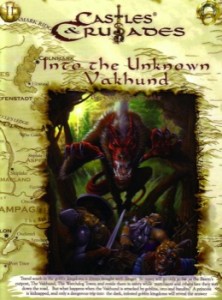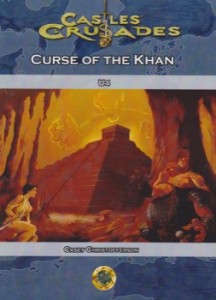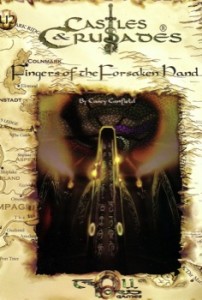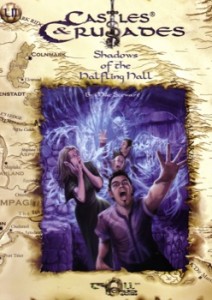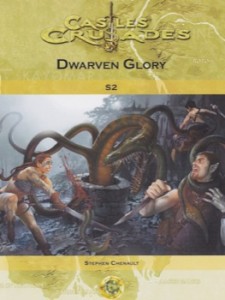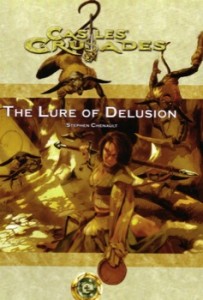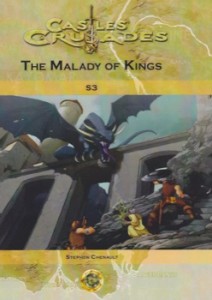
This is an adventure module for Castles & Crusades. It can be used with any pre-4.0 version of D&D. More on that at the end. It has a very very good set up that is spoiled by the verbosity of the material and brevity of the actual substance.
In ages past, the god known as the Dreaming Paladin was a mortal man. He sailed in to the Sea of Dreams leaving his wife behind. She died waiting for him to return and now rests uneasy in her tomb. This disruption in the force was noticed by a lieutenant-wizard of the Great Evil and used to ensnare and trap the Paladin god in a long winters nap.
This is a rather lengthy module, coming in at just over 40 pages. It also has a GREAT deal of exposition in it. I only counted six brief encounter areas in it, and most of those should not involve combat. I point this out because OH MY GOD there’s a great number of words present. The backstory is long and involved and comes much in the way of trivia, almost none of which is needed. A portion of it was kind of interesting. The Dreaming Paladin God is a nice concept, as is his ensnarement by the Sauron-like figure. The fleshing out of the family tree, and all of the other detail is superfluous to the adventure. I’m not sure why it’s there. Tolkien was great however every adventure module doesn’t need that much exposition. Be Terse. Get to the point. Leave some mystery. The first eleven pages has one encounter area, the hook. Anyway, I’ll get to that part later.
One day while our high-level adventuring party is walking about they stumble upon a windmill with a body outside. Inside they find a magic book, and a demon then appears who tries to take it from them. The book describes the lost tomb complex of the most famous royal family ever. A RICH one. Off go the PC’s to find the tomb and loot it. The hook is a bit silly. Besides the 11 pages it took to get to it, it doesn’t jive too well. There’s nothing special about the windmill, and the demon is a bit of an idiot, his charade wouldn’t last one round with a good group. He’s also not much of a challenge, seeing as he’s a lone warrior. He’s a bit of Lloth-like creature, decent AC, low HP, some immunities, and short life-span.
The party then gets to trek overland through a forest to find the tomb. There’s a nice little wandering monster chart with a lot of fey-like creature on it. There’s no detail to them though, so it’s the ‘ol hack /em to bits routine for the party. Stats are not included. There are a couple of other encounters available also: charcoal burners and the like. THAT’S what I want to see on a table; something unusual with a reason for wandering around other than ‘Kill PC.” Anyway, the party is about a day from the forest and the tomb is three days inside it.
On to the tomb. The party stumbles on to some worked stones in a stream in the forest, which is the clue that a man-made structure lies nearby. That’s the kind of stuff I’m looking for. It’s a nice evocative image. FInding the tomb the party gets to answer a series of riddles to get in. Oh Boy! I Love Riddles! And Players do also! Fortunately the author recognizes this and provides for several other means to enter the tomb besides answering the riddles. The tomb is going to be a let down. There IS some non-standard treasure available OUTSIDE the tomb, but inside the party isn’t going find anything. Well, anything besides the crypts of some great kings second cousin, twice removed. Oh, and a ghost. Hopefully the party doesn’t hack her to death. She tells them she wants her husbands ring back. Great, no treasure but a ghost fetch quest instead. Oh, and there’s a horn present. BTW: her husbands the dreaming paladin god.
If the party takes the horn to a monastery nearby then they can summon a dream ship to get to the dreaming paladin god who lives on the dream sea full of dreaming … ok you get the point. The Monastery has one of the worlds most confusing maps ever associated with it. I’ve read it over five times and I still can’t figure out what’s going on. There’s a small little encounter with a group of baddies in the compound. They are NOT going to be challenge for the party. Six 4HD creatures are nothing more than a gnat on the windshield. It’s not even a good resource-drainer since the time between encounters is so long the party can recover spells.
Traveling through the dream sea the party faces their worst nightmares. Yawn. They also come to an island of dreams that they may mistake for their destination. Across the Bridge of Apathy (how apropos …) it has a citadel with X number of dream warriors in it, where X is the number of party members. It also has some loot. Yeah! Treasure! Nine lives stealer, potion of +1 CHR, scroll of greater dispelling, arrow of dragon slaying … that’s some PHAT L00T!. The party then presumably moves on to the real island of dreaming dreams where the dream lord dreams a dream of … oops, sorry stuck again. The main island has four encounters on it. There’s an inn run by a very lonely god of carousing, who’s had no guests in a bajillion years and is now trying too hard. There’s a dragon guard, which WILL be a tough encounter, if the party is too stupid to parley. There are a few demons; 5HD and AC15 … those aren’t going to last long. Some flavor text and a couple of traps gets the party to the dreaming god, where the characters receive a +1 CON and +1 WIS award. Sauron never makes an appearance.
This thing has problems. There are some clear Tolkien influences, Earendil, Sauron, and the like. Maybe it’s a bit like the Heros Journey and they all look this way … I dunno. The set up is a good one, I was very excited by it. Dreaming Paladin god, capture of a god, ghostly wife awaiting his return … good stuff. Its just swamped by the verbosity that is going on coupled with the brevity of the actual adventure. I don’t need a dungeon and I don’t need an endless line of things to hack but geez, there has to be SOME substance to what’s going on. I think there’s only one encounter that can’t be avoided. Yeah, I like alternative solutions, but if you’re only going to have six encounters in a 44 page adventure then maybe one or two should be memorable?
The whole thing is poorly organized as well. It looks like they are trying to use section headings to differentiate the various portions of the adventure. Unfortunately, the headings all come across as exactly the same. This leaves me feeling like I don’t know where one section begins and another ends. It’s not keyed in a traditional sense, which is ok in theory, but in practice the headings just confuse and obfuscate the layout. The lack of a traditional key, and perhaps some map translation issues, also greatly impact the monastery. I was totally confused over it’s layout, and still am. Most of the wandering encounters in the main forest are not very interesting, and none of them on the island of dreams are.
This is available at DriveThru.
https://www.drivethrurpg.com/product/87519/Castles–Crusades-S3-The-Malady-of-Kings?affiliate_id=1892600

